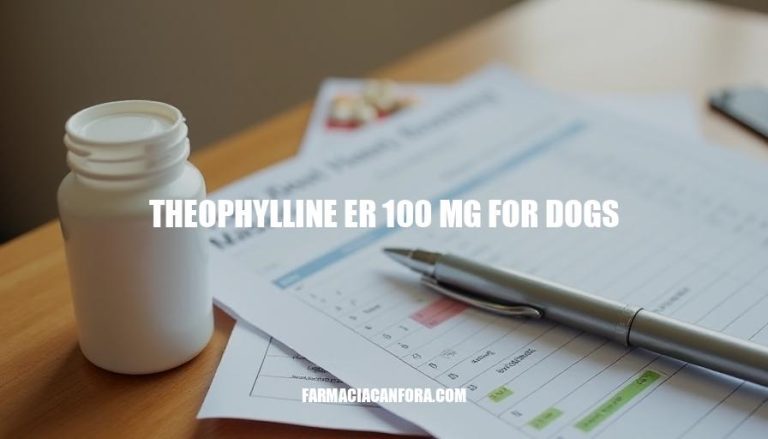


Theophylline is a medicine used to help dogs with breathing problems. It makes it easier for them to breathe by relaxing the muscles around their airways. This helps with conditions like asthma, bronchitis, and COPD.
Theophylline ER 100 mg is typically used to treat respiratory conditions in dogs, such as asthma, bronchitis, and chronic obstructive pulmonary disease (COPD). The dosage of theophylline must be individualized based on the dog’s weight, medical history, and specific needs. It is crucial to follow the veterinarian’s prescription and closely monitor the dog’s response to the medication.
Recommended Dosage:
The general dosage for dogs is 4.5 – 6.8 mg/lb every 12 hours (twice daily), or 9 mg/lb once daily using 24-hour extended-release pills.
For example, a dog weighing 20 pounds would typically start with around 90 mg of theophylline, which would then be adjusted based on the dog’s response to the drug.
Administration Instructions:
With Food: Administer theophylline with food to help avoid vomiting.
Extended-Release Tablets: Do not chew or crush the extended-release tablets, as this can affect the release and absorption of the medication.
Monitoring: During treatment, the dog should be carefully monitored for relief of symptoms and tolerance to the drug.
Adjust the dosage as needed to balance side effects with effectiveness.
Liver Failure: If the dog has liver failure, reduce the dosage by half.
Factors to Consider:
Weight: Dosage may need to be adjusted based on the dog’s lean body weight, especially in very overweight dogs.
Medical History: Dogs with heart, liver, or kidney disease, seizure disorders, hyperthyroidism, stomach ulcers, high blood pressure, hypoxia, or arrhythmia may not be suitable for theophylline treatment.
Drug Interactions: Theophylline interacts with various medications, including some antibiotics, thyroid medication, furosemide, and phenobarbital. Always inform the veterinarian of any other medications the dog is taking.
Pregnancy and Nursing: Theophylline should not be given to pregnant or nursing animals.
Monitoring and Follow-Up:
Regularly monitor the dog’s response to the medication and report any adverse effects to the veterinarian immediately.
Adjust the dosage as recommended by the veterinarian based on the dog’s response and any side effects observed.
Following the veterinarian’s prescription and closely monitoring the dog’s response to theophylline is essential to ensure the medication’s effectiveness and safety. Always consult the veterinarian for any concerns or questions regarding theophylline treatment for your dog.
:
Theophylline ER 100 mg can cause several potential side effects in dogs, including:
Pet owners should watch out for these side effects and report them to the veterinarian immediately. If the dog experiences any of the following, seek veterinary assistance right away:
To handle adverse reactions, pet owners should:
Regular check-ups with the veterinarian are crucial to ensure the effectiveness and safety of theophylline treatment. Pet owners should adhere to the prescribed regimen and report any concerns or questions to their veterinarian.
In addition, pet owners should be aware that theophylline can interact with other medications, including antibiotics, thyroid medication, furosemide, and phenobarbital. They should inform their veterinarian of any other medications their dog is taking to avoid potential interactions.
It’s also essential to note that theophylline should not be given to pregnant or nursing animals, as it may cause harm to the developing fetus or baby.